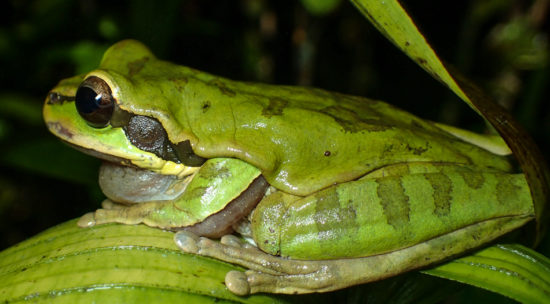
Smilisca

Smilisca
A common rain frog throughout much of the mid-elevations in Costa Rica, Craugastor underwoodi is abundant in Las Cruces.
Some results of a night stroll at Las Cruces during the NAPIRE mentor workshop.
During NAPIRE 2013, a couple of mentors and the station director at Las Cruces Biological Station decided to set up iButtons to remotely monitor temperature and relative humidity at 100 m increments along an elevation gradient. The aim was to place an iButton from 1100 m to 1400 m at the reserve at Las Cruces, then include the forest at Las Alturas to monitor 1500 to 2100 m.
I helped to set out the sensing units at Las Cruces, and this past year, during NAPIRE 2015, I happened across one of them… I recognized the site when visiting Katie’s butterfly roosting experiment.
Jerry, one of my NAPIRE students from Pohnpei, Micronesia, is investigating pseudothelphusidae crab (Allacanthos pittieri) populations at the Las Cruces Biological Station this summer. His study has two major components: (1) measuring crab densities in areas that vary in the amount of leaf litter present (i.e., high and low leaf litter densities), and (2) assessing predation risk in high and low leaf litter areas (after Jenn Clark’s crayfish study; Clark et al. 2013 Hydrobiologia). Jerry hopes to demonstrated higher crab densities and lower predation risk in areas of high leaf litter because crabs are able to use the leaves as refuge and a source of food, both directly, as they are shredders, and indirectly by preying on other invertebrates in the leaf litter.
Here, Jerry has tethered crabs using monofilament fishing line to flagging in about 20 stream pools. The crabs were paired in pools and restricted to either high leaf litter sections or low leaf litter sections of each pool site.
One of the dinners in 2013’s NAPIRE program was prepared by some students and staff.
A basidiomycete (Nidulariaceae), the fruiting bodies of this saprotrophic fungus resembles eggs in a bird nest.
The sunrise and sunset at the La Leona field station in Parque Nacional Corcovado in 2010.
A highly impacted sampling site for Mike Monfredi’s work on Osa fishes back in 2010.